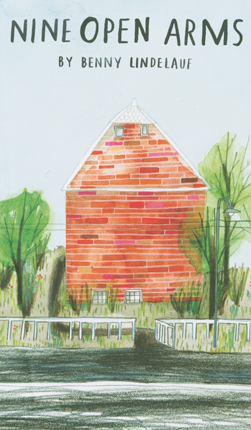| Nine open arms Author: Lindelauf, Benny | ||
| Price: $6.50 | ||
Summary:
When the Boon family moves into an old, ramshackle house at the very edge of a small town in the Netherlands, Oma Mei, the grandmother of seven motherless children, relates the house's remarkable origin in the 1860s.
| Reading Counts Information: Interest Level: 6-8 Reading Level: 3.80 Points: 15.0 Quiz: 65770 | ||
Reviews:
Kirkus Reviews (+) (05/15/14)
School Library Journal (00/06/14)
The Bulletin of the Center for Children's Books (00/09/14)
Full Text Reviews:
School Library Journal - 06/01/2014 Gr 5–8—The Boon family is down on their luck when they move into a leaky old house on the edge of town. Fing and her sisters sense the house and adjacent cemetery have a macabre past, and they defy their strong-tongued grandmother to explore the dank cellar and curious hole in the hedge. Between the mysterious house, a spitfire sister, schoolyard bullying, and their father's latest bumbling get-rich-quick scheme, nothing goes according to any sort of predictable plan—either for the Boons or readers who will be drawn into their story. The translation from the original Dutch is fluid with nuanced language and tone, allowing kids to inhabit a world at once strange, engaging, and richly historical. A fine addition for large collections.—Amy Koester, St. Charles City-County Library District, Wentzville, MO - Copyright 2014 Publishers Weekly, Library Journal and/or School Library Journal used with permission.
Bulletin for the Center... - 09/01/2014 When her perpetual dreamer father attempts yet another business venture, it’s off to another house for Dutch eleven-year-old Fing, her six siblings, father, and maternal grandmother Oma Mei, who has looked after the “half-orphans” following the death of their mother some nine years prior. The children depend on their sharp-tongued but devoted Oma Mei for guidance, brusque affection, and the occasional family story to bolster them as they wait to finally feel at home. Their newest residence, dubbed “Nine Open Arms” for the girls’ method of measuring its length, contains elements that hint at a “tragical tragedy,” one that Fing soon realizes her grandmother already knows. However, Oma Mei only shares the stories she wants when she wants, and Fing, beginning to understand that not every tale her grandmother tells is true, pushes for honesty, even if it exposes the cracks in the family’s foundation. Set in the mid-1930s Netherlands, this subdued but heartfelt work of domestic fiction subtly explores family dynamics and personal yearning, with particular insight into sisterly relationships and the obligations of eldest daughters. The story of the house and its original owners, when finally revealed, is an engaging and poignant tale in its own right, adding textures of romance and friendship to Fing’s family-focused narration. This is a quiet novel for readers who, like Fing, know that patience and perseverance can have considerable rewards. With the help of a provided glossary, aspiring linguists may enjoy wrestling with the Dutch slang peppered throughout. AA - Copyright 2014 The Board of Trustees of the University of Illinois.



